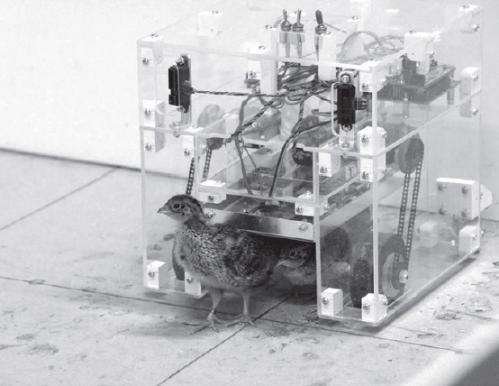September 22, 2011 report
Robot influences behavioral development of quail chicks

(PhysOrg.com) -- In one of the latest studies in the growing field of animal-robot interaction, researchers have found that young quail chicks that interact with autonomous mobile robots have improved spatial abilities later in life, at least up to a point. The results not only show the potential impact of robots on animal development, but also provide insight into the factors that play important roles in that development.
The researchers, E. de Margerie, et al., from the University of Rennes 1 in Rennes, France, have published their study in a recent issue of Bioinspiration & Biomimetics.
Although previous research has shown the importance of the mother hen in the development of quail chicks, using a mobile robot in place of the hen allowed the researchers to assess the impact with greater control. In their experiments, they divided 24 Japanese quail chicks into six groups of four. When the chicks were 36 hours old, the researchers began putting three of the groups in a cage with a heated mobile robot and the other three groups in a cage with the same heated robot, but with the locomotion feature disabled. Both of the cube-shaped robots had corridors between the wheels where the chicks could go to keep warm.
All six groups of chicks met with their robot for one hour per day for 10 days. During this time, the autonomous mobile robot would occasionally move around the cage at random intervals, often followed by the chicks. In the control group, the robot remained stationary.
After the 10 days of robot-quail meetings, the researchers began performing tests on the chicks. On the 13th day, the researchers placed the chicks back with their robots and observed that the chicks that spent time with the mobile robot moved around the cage much more actively and emitted more distress calls than the chicks that spent time with the stationary robot. However, the next day the researchers placed the chicks in the cage without robots, and although the chicks that met the mobile robot were still more active than the others, the difference was no longer significant.
On the 14th day, the researchers made each chick face a grid between itself and three unfamiliar chicks. They found that the chicks that spent time with the mobile robot navigated around the grid more quickly than the other chicks (almost twice as quickly, on average). However, when the researchers repeated the test on the 20th day, the chicks that had spent time with the stationary robot improved their performance so that the difference was no longer significant.
The results show that, five days after separation from the robots, the mobile robot improved the spatial learning and exploration skills of the chicks. Yet the impact was probably transitory, as the other chicks seemed to catch up with their peers after another five days.
Although the effect was short-lived, the experiment is one of the first that shows how an autonomous robot can influence the behavioral development of animals. The researchers predict that more refined robots and prolonged meeting sessions may have stronger and more long-lasting effects on young animals. And, from the perspective of behavior development, the study shows that robots can underscore the results of past studies that show the importance of a mother hen’s mobility on the normal development of her chicks.
More information: E. de Margerie, et al. “Influence of a mobile robot on the spatial behavior of quail chicks.” Bioinsp. Biomim. 6 (2011) 034001 (8pp). DOI:10.1088/1748-3182/6/3/034001
© 2011 PhysOrg.com


















